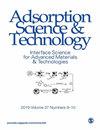Sorption and Environmental Risks of Phosphorus in Subtropical Forest Soils
IF 2.8
4区 工程技术
Q2 CHEMISTRY, APPLIED
引用次数: 3
Abstract
Phosphorus (P) is one of the key limiting factors for the growth of forests and their net primary productivity in subtropical forest ecosystems. Phosphorus leaching of the forest soil to the catchment and groundwater in karst region is the main source of water eutrophication. Strong P sorption capacity of minerals is generally assumed to be a key driver of P leaching in subtropical ecosystems which varies among different soil types. Here, we estimated P adsorption capacity of the O/A and AB horizon in both limestone soil and red soil of subtropical forests by fitting the Langmuir and Freundlich isotherm to investigate the potential environmental risks of P. The maximum P sorption capacity ( Q m ), P sorption constant ( K L ), P sorption index (PSI), degree of P saturation (DPS), and maximum buffer capacity (MBC) were calculated. The results indicate that Q m of the O/A horizon in both soils were similar. Comparing these two soils, the red soil had a higher K L and MBC in the AB horizon; Q m of limestone soil was larger but K L was lower, indicating that the adsorption capacity of limestone soil was weaker and MBC was lower. There was no significant difference in PSI between the two soils. The DPS values of both soils were below 1.1%, indicating that P saturation is low in both subtropical forest soils due to the lack of marked anthropogenic disturbance. In the O/A horizon, P saturation associated with available P (DPSM3 and DPSOlsen) and that associated with P in the Fe-Al bound state (DPScitrate) were higher in the red soil than in the limestone soil. DPS did not differ significantly in the AB horizon, except for higher DPSM3 and DPScitrate in the red soil. The findings highlight the influence of the soil types on P adsorption. The P adsorption and buffering of red soils were higher than those of limestone soils, indicating a lower risk of P leaching in red subtropical forest soils.亚热带森林土壤磷的吸附及其环境风险
磷(P)是亚热带森林生态系统中森林生长及其净初级生产力的关键限制因子之一。喀斯特地区森林土壤对集水区和地下水的磷淋滤是水体富营养化的主要来源。矿物对磷的强吸附能力通常被认为是亚热带生态系统磷淋溶的关键驱动因素,不同土壤类型对磷淋溶的影响不同。本文通过拟合Langmuir和Freundlich等温线,估算了亚热带森林石灰岩土和红壤O/A和AB层对磷的吸附量,探讨了磷的潜在环境风险,计算了最大磷吸附量(Q m)、磷吸附常数(K L)、磷吸附指数(PSI)、磷饱和度(DPS)和最大缓冲容量(MBC)。结果表明,两种土壤的O/A层Q m值相近。红壤AB层的K - L和MBC均高于红壤;石灰石土壤的Q m较大,K L较低,说明石灰石土壤的吸附能力较弱,MBC较低。两种土壤的PSI无显著差异。两种土壤的DPS值均低于1.1%,表明由于缺乏明显的人为干扰,两种亚热带森林土壤的磷饱和度都较低。在O/A水平,与有效磷(DPSM3和DPSOlsen)相关的磷饱和度以及与铁铝结合态(DPScitrate)相关的磷饱和度在红壤中高于石灰岩土。除红壤的DPSM3和DPScitrate较高外,AB层的DPS差异不显著。研究结果强调了土壤类型对磷吸附的影响。红壤对磷的吸附和缓冲作用高于石灰岩土,表明红壤亚热带森林土壤磷淋溶风险较低。
本文章由计算机程序翻译,如有差异,请以英文原文为准。
求助全文
约1分钟内获得全文
求助全文
来源期刊

Adsorption Science & Technology
工程技术-工程:化工
CiteScore
5.00
自引率
10.30%
发文量
181
审稿时长
4.5 months
期刊介绍:
Adsorption Science & Technology is a peer-reviewed, open access journal devoted to studies of adsorption and desorption phenomena, which publishes original research papers and critical review articles, with occasional special issues relating to particular topics and symposia.
 求助内容:
求助内容: 应助结果提醒方式:
应助结果提醒方式:


